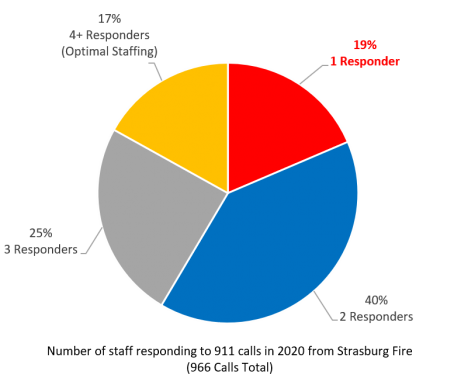Mill Levy Ballot Question 7A
Strasburg Fire Protection District would like to thank its community for years of support. Born as a 100% volunteer department in 1922, it was members that cared for our community to build and sustain the department to become what it is today. However, much has changed since then and Strasburg has grown dramatically, outpacing its humble beginnings. To adapt, the Strasburg Fire board of directors approved a proposal to increase mill levy ballot initiative to ask for an additional 4.9 mills for a total of 12.6144 mills. If approved, this will be the first mill levy increase since 1996, 25 years ago.
What will the mill levy be used for?
1. Staffing – 2.5 firefighters per 48/96 hour shift (Times shown below are example only)
|
2. Establishment of an apparatus replacement fund over a 10-year front line cycle, 20 years for reserve cycles. |
3. Department administrative needs including: office staffing, overtime and more. |
What will this cost me?
How property taxes are calculated: Arapahoe County "Understanding Property Taxes" Guide

Why can’t we just do things the way we always have?
To summarize, Strasburg isn’t the same town it was 25 years ago and with growth comes new challenges. Here’s a snapshot of key changes:
Year | 1996 | 2021 |
|---|---|---|
Population | 2,528 | 5,469 |
911 Calls | ~300 | 966 |
State Minimum Wage | $4.25/hr | $12.00/hr |
Avg Price of Diesel | $1.15/gal | $3.54/gal |
Strasburg’s population and call volume have risen dramatically over the years. While the community grows, the number of volunteers from the community has not and is the same yearly average as it was in 1996, about 30 volunteers now called “reserves”. To ensure continuity of service during periods of low reserve availability, Strasburg Fire hired 2 full time firefighter/paramedics to staff 2 of 3 shifts, but they staff the station alone 19% of the time. The third shift is staffed by Strasburg's Paramedic/Chief personally to ensure 24/7 ALS coverage in addition to his daily administrative duties. 1 firefighter cannot provide definitive medical care or successful firefighting efforts without help and must wait for mutual aid assistance from a neighboring district. Every minute matters to a person in distress.

The skills required of firefighters have also increased to include: hazmat response, firefighting with modern materials, extrication and constant training to maintain those skills to peak efficiency. Medical training has also increased. Paramedic tuition is approximately $9,500 and 1-2 years of training with 60 hours of continuing education every 2 years to maintain their certification. EMT tuition is approximately $2500 and 9 months of training with 30 hours of continuing education required to maintain their certification. All of these skills and time commitments are necessary in ADDITION to staffing regular shifts.
To summarize, change is already here and Strasburg Fire is asking for help to adapt to it.
Why can’t the department just ask for funding from the county, state or federal government?
As a “special district”, Strasburg Fire is primarily funded by property taxes and EMS revenue. It does not receive funds from the counties it serves, sales taxes, vehicle registrations or federal highway funding. The department has applied for grants from the state and federal government to delay this proposal, however, the awards received come with strict stipulations on how the funds may be spent. Cost matching is nearly always required and may only be used to purchase equipment, not staffing, which is the fire department’s greatest need.
How do we know that Strasburg Fire won’t be back in a few years asking for more money?
Strasburg Fire Protection District has a proud history of fiscal responsibility which is demonstrated by the last 25 years since its last mill levy increase. The proposal in this ballot is the result of careful consideration of the community construction/population growth trends, 911 usage, department apparatus assessments and staffing needs. To ensure long term sustainability, a 3 year economic analysis was performed to ensure the new mill levy rate would meet the community’s needs for years to come.
Why does the ballot contain a TABOR exemption?
This is actually not a new exemption, but a request to retain the same exemption Strasburg Fire has had since 1998. All fire departments on the I-70 Corridor have one including Bennett-Watkins Fire and Byers Fire. In accordance with Colorado state law, any time there is a modification to taxes, the exemption must be reaffirmed by the voters. This exemption is necessary to enable the department to have a savings account to respond to unforeseen events (changing fuel costs, equipment repairs and etc.) in a timely manner to preserve the level of services which Strasburg currently enjoys. Just as “rainy days” can happen to a family, they can and do happen to fire departments too.

